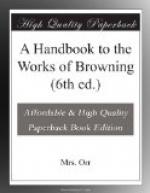Many of Mr. Browning’s poems are founded on fact, whether historical, or merely of known occurrence; but few of them can be classed by their historic quality, because it is seldom their most important. In “Prince Hohenstiel-Schwangau,” for instance, we have a chapter in recent history: but we only read it as an abstract discussion, to which a chapter in history has given rise; and in “Pacchiarotto, and how he worked in Distemper,” and “Filippo Baldinucci on the Privilege of Burial” (published in the same volume), we find two incidents, each of them true, and each full of historic significance; but which owe all their vitality to the critical and humorous spirit, in which Mr. Browning has described them. The small list of poems which are historical more than anything else, might be recruited from the Dramatic Idyls; but, for various reasons, this publication must stand alone; and even here, it is often difficult to disengage the actual fact, from the imaginary conditions in which it appears. Our present group is therefore reduced to—
“Red Cotton Night-Cap
Country; or, Turf and Towers.” (1873.)
“The Inn Album.”
(1875.)
“The Two Poets
of Croisic.” (1878.)
“Cenciaja.”
("Pacchiarotto, and other Poems.” 1876.)
We may also place here, as it is historical in character, “The Heretic’s Tragedy; a Middle Age Interlude” ("Dramatic Romances.” Published in “Men and Women.” 1855.)
The real-life drama which Mr. Browning has reproduced under the title of “Red Cotton Night-cap Country,” was enacted partly in Paris, partly in a retired corner of Normandy, where he spent the late summer of 1872; and ended in a trial which had been only a fortnight closed, when he supposes himself to be relating it. His whole story is true, except that in it which reality itself must have left to the imagination. Only the names of persons and places are fictitious.[78]
The principal actor in this drama, Leonce Miranda, was son and heir to a wealthy Spanish jeweller in the Place Vendome. He was southern by temperament as by descent; but a dash of the more mercantile Parisian spirit had come to him from his French mother; and while keenly susceptible to the incitements of both religious and earthly passion, he began life with the deliberate purpose of striking a compromise between them. At an early age he determined to live for this world now, and for the other when he was older; and in the meantime to be moderate in his enjoyments. In conformity with this plan he ran riot on Sunday; but worked diligently during the rest of the week. He bestowed his fancy on five women at once; but represented himself, when in their company, as a poor artist or musician, and wasted no money upon them.




